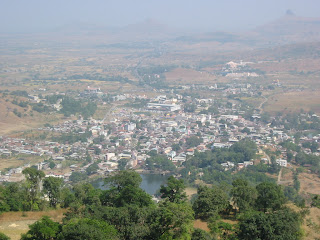Before we left Mumbai Dad and I visited Matunga, a suburb of Mumbai where my Mom grew up and where both my Mom and Dad went to college. We visited a very good friend of Dad’s, Gangadasbhai, who helped arrange Mom and Dad’s marriage. We also visited the Kapol boarding house where my Dad stayed while he went to college. After lunch we took a pre-paid Taxi to
Sudaben met us at the taxi stand and took us home to freshen up before we went to see her Blue Dart office. Blue Dart is a national courier service that was recently bought by DHL, which has made Sudaben’s life much busier. She’s the head manager of the
After returning home for a quick dinner, we caught a show for Om Shanti Om, Shah Rukh Khan’s big Diwali movie. It was ok, one good song and a few nice scenes including a wonderful spoof on Bollywood during an award ceremony, but overall it was too loud and hectic and by the end you get a little tired of watching SRK, since he’s in almost every frame. My favorite part was actually the credits, where the people who helped make the film from got to dress up and walk down the red carpet. Not just the stars mind you, but the assistant directors, make-up artists, camera operators, and even the grips got their time on the screen. And the director Farah Khan arrived last in a beat up rickshaw to find that everyone had left. It was probably all the jokes about Bollywood celebrities that I enjoyed the most in the film.
The next morning we went to Thamkeshwar, a temple about 20 km outwide of

We drove back home for lunch and after a short rest headed out again, this time to see ‘Old
We went to one area called Panchavati, named after the five banyan trees that grow there. Dad and I visited a temple for Lord Ram, in which visitors entered and exited through staircases so small that we literally had to crawl. I felt a lot like
Dad and I left for Mumbai the next morning in a shared taxi. All in all it was a nice, relaxing weekend, and gave us a much needed break from the stress of the past few days.





